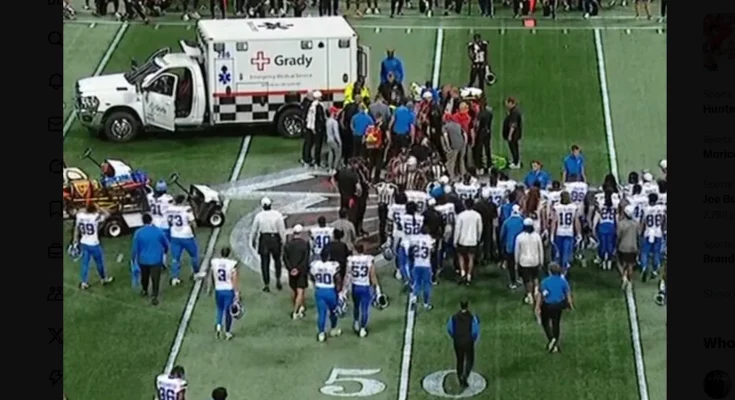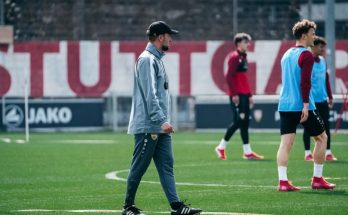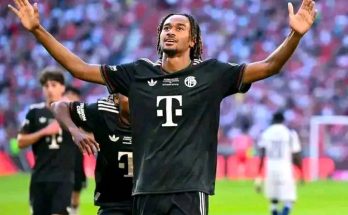The roar of the crowd fell silent as Detroit Lions defensive back Morice Norris lay motionless on the field. What had begun as a routine play quickly turned into a nightmare when Norris was struck in the head by an Atlanta Falcons player during a high-speed collision. The impact was immediate and horrifying—Norris did not get up. Medical personnel rushed onto the field as teammates knelt in prayer, their faces etched with concern. Minutes later, Norris was carefully loaded onto a stretcher and taken away in an ambulance, leaving fans, players, and coaches shaken by the severity of the injury.
This incident is yet another grim reminder of the physical toll football exacts on its players, particularly when it comes to head injuries. While the sport is celebrated for its intensity, strategy, and athleticism, moments like these force the NFL and its fans to confront the inherent dangers of the game.
### **The Play That Changed Everything**
The hit occurred during the third quarter of a tightly contested game between the Lions and Falcons. Norris, known for his aggressive playing style and hard hits, was covering a Falcons receiver on a deep pass. As the ball sailed through the air, both players leaped for it, but the receiver’s shoulder collided directly with Norris’s head. The sickening sound of the impact echoed through the stadium, and Norris collapsed to the ground, his body limp.
Medical staff immediately signaled for assistance, and the game was halted. Players from both teams took a knee, some visibly emotional, as trainers and doctors attended to Norris. After several tense minutes, he was immobilized and placed on a backboard before being wheeled off the field. The ambulance’s departure was met with a standing ovation from fans, a small but heartfelt gesture of support for a player whose future now hung in the balance.
### **The Immediate Aftermath**
Following the incident, the Lions released a statement confirming that Norris had been transported to a local hospital for further evaluation. Early reports indicated concerns about a severe concussion, possible spinal involvement, or even more catastrophic head trauma. The team, while hopeful, acknowledged the seriousness of the situation.
Teammates and opponents alike took to social media to express their support. Falcons quarterback Matt Ryan tweeted, *“Praying for Morice Norris. Nobody wants to see that happen to any player.”* Lions head coach Dan Campbell, known for his emotional leadership, spoke somberly in the post-game press conference: *“This is the part of the game that keeps you up at night. Morice is a fighter, and we’re all behind him.”*
### **The Broader Issue: Head Injuries in Football**
Norris’s injury is far from an isolated incident. The NFL has long grappled with the issue of head trauma, particularly chronic traumatic encephalopathy (CTE), a degenerative brain disease found in many former players. Despite rule changes aimed at reducing dangerous hits—such as penalties for helmet-to-helmet contact and targeting—violent collisions remain an unavoidable part of the game.
Recent years have seen advancements in helmet technology, concussion protocols, and stricter enforcement of player safety rules. However, critics argue that more must be done. Some suggest eliminating certain types of tackles altogether, while others advocate for better post-career medical support for players suffering from long-term brain injuries.
### **The Human Cost Beyond the Field**
For Norris, the injury is more than just a temporary setback—it’s a life-altering event. The road to recovery for severe head injuries can be long and uncertain. Some players return to the field after weeks or months of rehabilitation, while others are forced into early retirement due to lingering symptoms like memory loss, dizziness, or emotional instability.
Former players who have suffered similar injuries have spoken out about the challenges they face. Ryan Shazier, the Pittsburgh Steelers linebacker who suffered a spinal injury in 2017, has been open about his grueling recovery process. While he eventually regained the ability to walk, his playing career was over. Stories like his underscore the risks players take every time they step onto the field.
### **The NFL’s Responsibility**
The league has made strides in addressing player safety, but incidents like Norris’s injury prove that football will always carry significant risk. The NFL must continue investing in research, improving equipment, and refining rules to minimize preventable injuries. Additionally, ensuring that injured players receive the best possible medical care—both immediately and long-term—should remain a top priority.
Fans also play a role. While the excitement of big hits and aggressive plays is part of football’s appeal, there must be a collective acknowledgment of the human cost. Cheering for a player’s injury, even unintentionally, perpetuates a culture that prioritizes entertainment over well-being.
### **Looking Ahead: What’s Next for Norris and the Lions?**
As of now, Norris’s condition remains uncertain. The Lions organization has promised updates as more information becomes available, but the focus remains on his health rather than his return to football. His teammates will undoubtedly play with heavy hearts in the coming weeks, using his injury as both a cautionary tale and a rallying point.
For the NFL, this is another moment of reckoning. How much longer can the sport continue at its current level of violence before more drastic changes are necessary? While no one wants to see football lose its edge, player safety must come first.
### **Conclusion: A Game of Risk and Resilience**
Football is a sport built on toughness, resilience, and sacrifice. Players like Morice Norris embody those qualities every time they step onto the field. But as fans, coaches, and league officials, we must ask ourselves: At what point does the risk outweigh the reward?
Norris’s injury is a heartbreaking reminder of the fragility of even the strongest athletes. As the football world waits for news on his condition, one thing is clear: The conversation about player safety is far from over. The hope now is that Norris makes a full recovery—and that his injury sparks meaningful change in how the game protects its players.
Until then, the NFL, its athletes, and its fans must grapple with the difficult truth that the sport they love comes at a price—one that is sometimes too high to pay.



